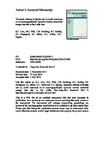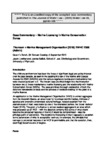Temporal patterns in habitat use by small cetaceans at an oceanographically dynamic marine renewable energy test site in the Celtic Sea
| dc.contributor.author | Cox, SL | |
| dc.contributor.author | Witt, MJ | |
| dc.contributor.author | Embling, Clare | |
| dc.contributor.author | Godley, BJ | |
| dc.contributor.author | Hosegood, Philip | |
| dc.contributor.author | Miller, PI | |
| dc.contributor.author | Votier, SC | |
| dc.contributor.author | Ingram, Simon | |
| dc.date.accessioned | 2016-07-19T09:51:59Z | |
| dc.date.available | 2016-07-19T09:51:59Z | |
| dc.date.issued | 2016-07-09 | |
| dc.identifier.issn | 0967-0645 | |
| dc.identifier.issn | 1879-0100 | |
| dc.identifier.uri | http://hdl.handle.net/10026.1/5067 | |
| dc.description.abstract |
Shelf-seas are highly dynamic and oceanographically complex environments, which likely influences the spatio-temporal distributions of marine megafauna such as marine mammals. As such, understanding natural patterns in habitat use by these animals is essential when attempting to ascertain and assess the impacts of anthropogenically induced disturbances, such as those associated with marine renewable energy installations (MREIs). This study uses a five year (2009–2013) passive acoustics (C-POD) dataset to examine the use of an oceanographically dynamic marine renewable energy test site by small cetaceans, dolphins (unspecified delphinids) and harbour porpoises Phocoena phocoena, in the southern Celtic Sea. To examine how temporal patterns in habitat use across the site related to oceanographic changes occurring over broad seasonal scales as well as those driven by fine scale (bi-weekly) localised processes (that may be masked by seasonal trends), separate analyses were conducted using (1) all daily animal detection rates spanning the entire five year dataset and (2) daily animal detection rates taken only during the summer months (defined as mid-June to mid-October) of 2010 (when continuous monitoring was carried out at multiple discrete locations across the site). In both instances, generalised additive mixed effects models (GAMMs) were used to link detection rates to a suite of environmental variables representative of the oceanography of the region. We show that increased harbour porpoise detection rates in the late winter/early spring (January–March) are associated with low sea surface temperatures (SST), whilst peaks in dolphin detection rates in the summer (July–September) coincide with increased SSTs and the presence of a tidal-mixing front. Moreover, across the summer months of 2010, dolphin detection rates were found to respond to small scale changes in SST and position in the spring-neap cycle, possibly reflective of a preference for the stratified waters immediately offshore of the front. Together, these findings suggest that habitat use by small cetaceans within shelf-seas is temporally variable, species specific and likely driven by complex bottom-up processes. As such, the effective conservation management of shelf-seas requires that we understand the dynamic complexities of these systems and the species that inhabit them. In particular, we emphasise the need for a good understanding of the natural drivers of habitat use by marine megafauna before the potential impacts of anthropogenically induced disturbances, such as those associated with the construction, maintenance and operation of MREIs, can be assessed. | |
| dc.format.extent | 178-190 | |
| dc.language | en | |
| dc.language.iso | en | |
| dc.publisher | Elsevier BV | |
| dc.subject | Marine predator | |
| dc.subject | Habitat use | |
| dc.subject | Fronts | |
| dc.subject | Passive acoustics | |
| dc.subject | Marine megafauna | |
| dc.subject | Marine mammals | |
| dc.subject | Dolphins | |
| dc.subject | Harbour porpoises Phocoena phocoena | |
| dc.subject | Common dolphins Delphinus delphis | |
| dc.subject | Oceanography | |
| dc.subject | Marine renewable energy | |
| dc.title | Temporal patterns in habitat use by small cetaceans at an oceanographically dynamic marine renewable energy test site in the Celtic Sea | |
| dc.type | journal-article | |
| dc.type | Journal Article | |
| plymouth.author-url | https://www.webofscience.com/api/gateway?GWVersion=2&SrcApp=PARTNER_APP&SrcAuth=LinksAMR&KeyUT=WOS:000405251400014&DestLinkType=FullRecord&DestApp=ALL_WOS&UsrCustomerID=11bb513d99f797142bcfeffcc58ea008 | |
| plymouth.volume | 141 | |
| plymouth.publication-status | Published | |
| plymouth.journal | Deep Sea Research Part II: Topical Studies in Oceanography | |
| dc.identifier.doi | 10.1016/j.dsr2.2016.07.001 | |
| plymouth.organisational-group | /Plymouth | |
| plymouth.organisational-group | /Plymouth/Faculty of Science and Engineering | |
| plymouth.organisational-group | /Plymouth/Faculty of Science and Engineering/School of Biological and Marine Sciences | |
| plymouth.organisational-group | /Plymouth/PRIMaRE Publications | |
| plymouth.organisational-group | /Plymouth/REF 2021 Researchers by UoA | |
| plymouth.organisational-group | /Plymouth/REF 2021 Researchers by UoA/UoA07 Earth Systems and Environmental Sciences | |
| plymouth.organisational-group | /Plymouth/Research Groups | |
| plymouth.organisational-group | /Plymouth/Research Groups/Marine Institute | |
| plymouth.organisational-group | /Plymouth/Users by role | |
| plymouth.organisational-group | /Plymouth/Users by role/Academics | |
| plymouth.organisational-group | /Plymouth/Users by role/Researchers in ResearchFish submission | |
| dcterms.dateAccepted | 2016-07-01 | |
| dc.rights.embargodate | 2018-1-9 | |
| dc.identifier.eissn | 1879-0100 | |
| dc.rights.embargoperiod | Not known | |
| rioxxterms.funder | Natural Environment Research Council | |
| rioxxterms.identifier.project | Assessing the sensitivity of marginally stratified shelf seas within a changing climate | |
| rioxxterms.versionofrecord | 10.1016/j.dsr2.2016.07.001 | |
| rioxxterms.licenseref.uri | http://www.rioxx.net/licenses/all-rights-reserved | |
| rioxxterms.licenseref.startdate | 2016-07-09 | |
| rioxxterms.type | Journal Article/Review | |
| plymouth.funder | Assessing the sensitivity of marginally stratified shelf seas within a changing climate::Natural Environment Research Council |



